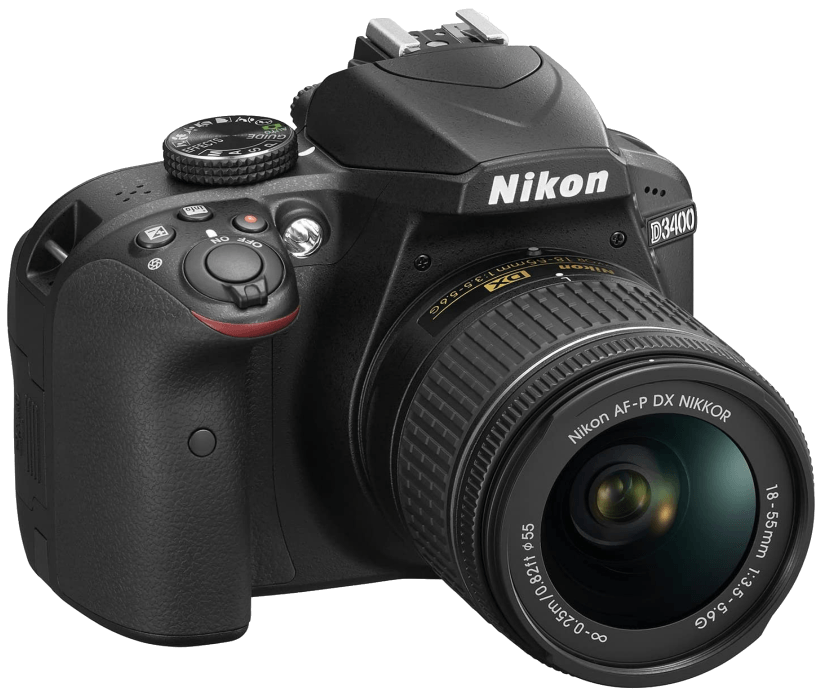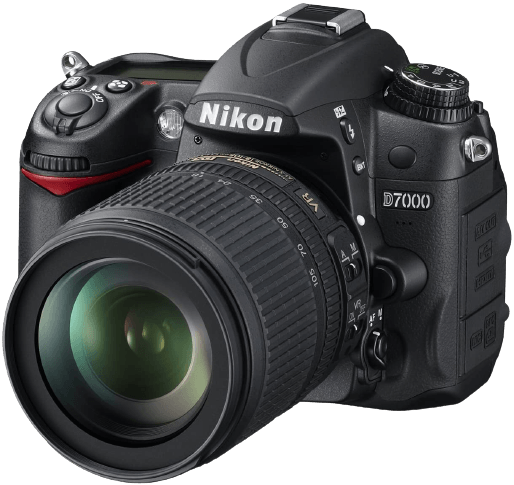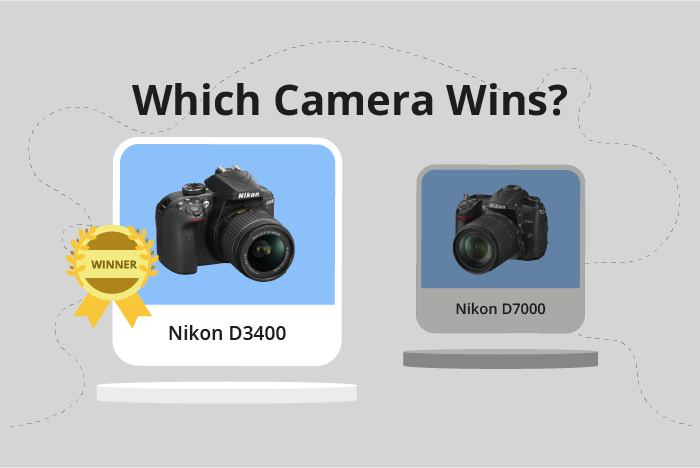Nikon D3400 vs D7000 Comparison
Nikon D3400

Nikon D7000

The Nikon D3400 outperforms the Nikon D7000 with a score of 61/100 compared to 56/100. Both cameras are DSLRs and have similar dimensions, with the D3400 measuring 124 x 98 x 76mm and the D7000 at 132 x 105 x 77mm. The D3400 has a clear advantage in weight, being significantly lighter at 445g compared to the D7000’s 780g.
The D3400 was released in 2016 with a launch price of $650, while the D7000 was released earlier in 2010 and had a higher launch price of $1200. Despite its lower score, the D7000’s higher price tag may reflect additional features or better build quality.
Taking these factors into account, the Nikon D3400 is the better option for those seeking a lighter and more affordable camera, while the Nikon D7000 might be more suitable for users who prioritize additional features or build quality.
Nikon D3400 vs D7000 Overview and Optics
The Nikon D3400 outperforms the Nikon D7000 in optics with a score of 65/100 compared to the D7000’s 55/100. Both cameras share some common specifications, such as the CMOS sensor type, APS-C sensor size, Nikon F lens mount, and lack of image stabilization. However, there are also notable differences that contribute to the D3400’s higher score.
The D3400 boasts a higher megapixel count at 24.2, compared to the D7000’s 16.2 megapixels. This allows the D3400 to capture more detailed images, providing better overall image quality. Additionally, the D3400 features a more advanced Expeed 4 processor, which improves image processing speed and performance. The D3400 also has a higher DXOMARK score for the sensor at 86, indicating better overall sensor performance.
Despite these advantages, the D7000 does have a faster shooting speed of 6 frames per second, compared to the D3400’s 5 frames per second. This could be beneficial for capturing fast-moving subjects or continuous shooting scenarios. However, this advantage is not enough to outweigh the D3400’s superior image quality and sensor performance.
Taking these factors into account, the Nikon D3400 clearly outshines the Nikon D7000 in terms of optics. With a higher megapixel count, more advanced processor, and better sensor performance, the D3400 is the stronger choice for capturing high-quality images. While the D7000 does offer a slightly faster shooting speed, this advantage is not enough to overcome the D3400’s other superior features.
Nikon D3400 vs D7000 Video Performance
The Nikon D7000 narrowly wins in the video department with a score of 57/100, while the Nikon D3400 trails closely behind with a score of 56/100. Both cameras share Full HD video resolution and maximum video dimensions of 1920 x 1080, providing equal video quality in terms of resolution.
The D7000 surpasses the D3400 in terms of video capabilities due to its built-in time-lapse functionality. This feature allows users to capture stunning time-lapse sequences without the need for additional equipment or post-processing. This advantage makes the D7000 more versatile for creative videography projects.
On the other hand, the D3400 offers a higher maximum video frame rate of 60fps, compared to the D7000’s 24fps. This higher frame rate enables the D3400 to capture smoother video, especially when recording fast-paced action or sports. This advantage may appeal to users who prioritize capturing fluid motion in their videos.
Taking these points into account, the Nikon D7000 proves to be a slightly better choice for videographers who value time-lapse capabilities and overall versatility. Meanwhile, the Nikon D3400 is a more suitable option for those who prioritize smooth video playback and capturing high-speed action. Ultimately, the decision between these two cameras will depend on the specific video requirements and preferences of the user.
Nikon D3400 vs D7000 Features and Benefits
The Nikon D3400 and Nikon D7000 both have a feature score of 54/100. This score reveals that these cameras have comparable features, with some differences between them.
Both cameras have a 3-inch screen size and a screen resolution of 921,000 dots. Neither camera has a touchscreen or a flip screen, and both lack GPS functionality. These similarities indicate that the user experience of the Nikon D3400 and Nikon D7000 is quite comparable in terms of display and navigation.
The Nikon D7000 is superior in terms of connectivity, as it has built-in WiFi. This feature allows users to transfer photos and videos wirelessly to other devices, making sharing and backing up files more convenient. On the other hand, the Nikon D3400 does not have WiFi capability.
The Nikon D3400 has an advantage in terms of Bluetooth connectivity. This feature enables users to connect the camera to a smartphone or other device for remote control and file sharing. The Nikon D7000, however, does not have Bluetooth functionality.
To summarize, both cameras offer similar features in terms of screen size, resolution, and lack of GPS. The Nikon D7000 is better for users who value WiFi connectivity, while the Nikon D3400 is better for those who prioritize Bluetooth connectivity. Users should consider their specific needs and preferences when choosing between these two cameras.
Nikon D3400 vs D7000 Storage and Battery
The Nikon D3400 and Nikon D7000 share common specs. Though both accept SD, SDHC, and SDXC cards, the D7000 accepts dual cards.
The Nikon D3400 takes the lead in battery life with 1200 shots, compared to the Nikon D7000’s 1050 shots. The D3400 uses an EN-EL14a battery type, contributing to its longer battery life.
On the other hand, the Nikon D7000 has an EN-EL15 battery type, which results in a slightly shorter battery life. However, this difference may not significantly impact most users’ shooting experiences.
Considering these factors, the Nikon D3400 is slightly better in terms of battery life, while both cameras possess the same storage capabilities. This information can help potential buyers make an informed decision based on their storage and battery life preferences.
Nikon D3400 vs D7000 – Our Verdict
Are you still undecided about which camera is right for you? Have a look at these popular comparisons that feature the Nikon D3400 or the Nikon D7000:

